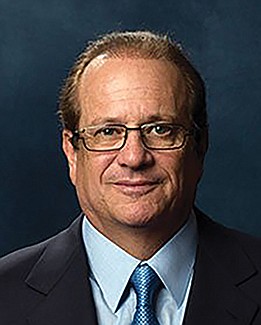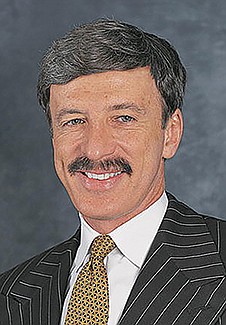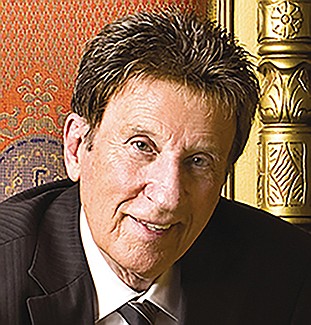 Facebook
Facebook
 X
X
 Instagram
Instagram
 TikTok
TikTok
 Youtube
Youtube

Billionaires make us bilious — suffering from indigestion, accompanied by nausea and perhaps vomiting. Billionaire pro sports team owners seem to take delight in making us feel this way.

The owners of the San Diego Chargers, the Spanos family, are petty billionaires — only worth $1.26 billion, according to Forbes magazine. The family’s net worth ranks a mere 16th among National Football League owners.

The Spanos family would love to steer its Chargers to Los Angeles. Stan Kroenke, a real estate developer worth $6.3 billion, according to Forbes, could either block or aid the Chargers’ bid to get to L.A. Kroenke got rich building Walmart stores and then married a member of the founding Walton family. She is Ann Walton Kroenke, worth $5.6 billion.
Kroenke plans to build a $1.86 billion stadium in the Los Angeles suburb of Inglewood. Sports scribes expect him to move the St. Louis Rams, which he owns, to Inglewood, although he could sell that team and buy into another, perhaps the Chargers or Oakland Raiders, who together claim that they will build a $1.7 billion stadium in Carson, also in the L.A. area.
Because the National Football League is essentially a shrine for wealth worship, the smart money is on Kroenke when owners vote on who gets to go to L.A. Since the Raiders’ major owner isn’t even a billionaire, the Chargers, rather than the Raiders, could be a second team performing in Inglewood.
What about other sports? Does basketball reek of greed, too? Yes. The richest pro sports team owner, Steve Ballmer, is worth $21.5 billion. He was one of the early employees of Microsoft and its chief executive for years, and he recently bought basketball’s Los Angeles Clippers. The second-richest sports team owner is Paul Allen, a cofounder of Microsoft, who is worth $17.5 billion and owns basketball’s Portland Trail Blazers, as well as football’s Seattle Seahawks.

The most nauseous adventure is now going on in Wisconsin. Governor Scott Walker wants citizens to subsidize principal owners of the Milwaukee Bucks basketball team — three New York–based hedge-fund plutocrats together worth well over $5 billion. They are demanding a new arena supported by taxpayers. Or else the team will be moved. Heard that before?
Walker is saying the cost of the subsidy will be $220 million, but financial sophisticates say if you count the real cost over the life of the bonds, the subsidy more than doubles that figure.
At the same time, Walker slashed $250 million out of the University of Wisconsin budget. He says a new basketball arena will enhance the economy — something that economists have shown conclusively doesn’t happen. Walker wants to be president of the United States.
A similarly regurgitative tale comes from the Atlanta Hawks professional basketball team. It was owned by Bruce Levenson, who made his money in communications but is a pauper worth only half a billion dollars. Last year, it came out that Levenson had sent an offensive message to his general manager in 2012. Levenson complained that the audience at games was “70 percent black. The cheerleaders are black. The music is hip hop. At the bars it’s 90 percent black.… Even [Washington, D.C.] with its affluent black community never has more than a 15 percent black audience.” Before he purchased the team, “in an effort to make the arena look full… thousands and thousands of tickets were being given away, predominantly in the black community, adding to the overwhelming black audience. My theory is that the black crowd scared away the whites and there are simply not enough affluent black fans to build a significant season ticket base.”
Last fall, Levenson, not surprisingly, decided to sell the team. The buyer this year was Antony Ressler, a Los Angeles financier worth $1.51 billion by Forbes’ reckoning. The first thing Ressler declared was that the Hawks’ arena, which was built in 1999, had to be remodeled or rebuilt because it was not in the upper quartile of arenas. “Declaring that your arena is obsolete because it’s 16 years old and there are seven nicer ones elsewhere is pretty ballsy,” says Neil deMause, who runs the fieldofschemes.com website. Verbiage like Levenson’s forced former San Diegan Donald Sterling (net worth $2.9 billion) to sell the Los Angeles Clippers to Ballmer for $2 billion.
Then come basketball’s Cleveland Cavaliers. They were bought in 1983 by Gordon Gund and George Gund III, sons of George Gund II, who was worth $600 million in the 1960s, when billionaires were scarce. The Gund brothers, worth $3.5 billion, got a new arena in downtown Cleveland, financed with sin taxes on the populace. They sold 72 percent of the team to Dan Gilbert, cofounder and chairman of Detroit’s Quicken Loans.
The Quicken Loans Arena in downtown Cleveland was built in 1994. This year, Gilbert wanted it to host a future National Basketball Association All-Star game. But the league commissioner said arena improvements would have to be made. The Cavaliers want a multimillion-dollar enlargement of the arena. “It sounds as if the county’s involvement is critical to getting it all accomplished,” says cleveland.com. Of course, taxpayer money will be used: Gilbert, who owns a Cleveland casino, is worth $4.7 billion and might plead poverty to local government.
Gilbert is a big landholder in downtown Detroit and a local hero for shelling out bucks to revive the place.

In July of 2013, Detroit went into Chapter 9 bankruptcy. But a taxpayer subsidy for the family of Michael and Marian Ilitch, worth $4.8 billion, according to Forbes, has gone ahead. Ilitch, who made the bulk of his fortune from Little Caesars Pizza, owns the Detroit Red Wings hockey team. His wife is listed as owner of the Detroit Tigers baseball team and a casino.
Now Ilitch has arranged to build a $450 million hockey arena near downtown. But only 42 percent of the money will come from private sources. The rest will come from public financing, largely through 30-year bonds.
Billionaire Tom Gores, whose company briefly owned the Union-Tribune, owns the Detroit Pistons basketball team, based in a Detroit suburb. There is talk of his moving the team to central Detroit — with a fat subsidy, of course.


Billionaires make us bilious — suffering from indigestion, accompanied by nausea and perhaps vomiting. Billionaire pro sports team owners seem to take delight in making us feel this way.

The owners of the San Diego Chargers, the Spanos family, are petty billionaires — only worth $1.26 billion, according to Forbes magazine. The family’s net worth ranks a mere 16th among National Football League owners.

The Spanos family would love to steer its Chargers to Los Angeles. Stan Kroenke, a real estate developer worth $6.3 billion, according to Forbes, could either block or aid the Chargers’ bid to get to L.A. Kroenke got rich building Walmart stores and then married a member of the founding Walton family. She is Ann Walton Kroenke, worth $5.6 billion.
Kroenke plans to build a $1.86 billion stadium in the Los Angeles suburb of Inglewood. Sports scribes expect him to move the St. Louis Rams, which he owns, to Inglewood, although he could sell that team and buy into another, perhaps the Chargers or Oakland Raiders, who together claim that they will build a $1.7 billion stadium in Carson, also in the L.A. area.
Because the National Football League is essentially a shrine for wealth worship, the smart money is on Kroenke when owners vote on who gets to go to L.A. Since the Raiders’ major owner isn’t even a billionaire, the Chargers, rather than the Raiders, could be a second team performing in Inglewood.
What about other sports? Does basketball reek of greed, too? Yes. The richest pro sports team owner, Steve Ballmer, is worth $21.5 billion. He was one of the early employees of Microsoft and its chief executive for years, and he recently bought basketball’s Los Angeles Clippers. The second-richest sports team owner is Paul Allen, a cofounder of Microsoft, who is worth $17.5 billion and owns basketball’s Portland Trail Blazers, as well as football’s Seattle Seahawks.

The most nauseous adventure is now going on in Wisconsin. Governor Scott Walker wants citizens to subsidize principal owners of the Milwaukee Bucks basketball team — three New York–based hedge-fund plutocrats together worth well over $5 billion. They are demanding a new arena supported by taxpayers. Or else the team will be moved. Heard that before?
Walker is saying the cost of the subsidy will be $220 million, but financial sophisticates say if you count the real cost over the life of the bonds, the subsidy more than doubles that figure.
At the same time, Walker slashed $250 million out of the University of Wisconsin budget. He says a new basketball arena will enhance the economy — something that economists have shown conclusively doesn’t happen. Walker wants to be president of the United States.
A similarly regurgitative tale comes from the Atlanta Hawks professional basketball team. It was owned by Bruce Levenson, who made his money in communications but is a pauper worth only half a billion dollars. Last year, it came out that Levenson had sent an offensive message to his general manager in 2012. Levenson complained that the audience at games was “70 percent black. The cheerleaders are black. The music is hip hop. At the bars it’s 90 percent black.… Even [Washington, D.C.] with its affluent black community never has more than a 15 percent black audience.” Before he purchased the team, “in an effort to make the arena look full… thousands and thousands of tickets were being given away, predominantly in the black community, adding to the overwhelming black audience. My theory is that the black crowd scared away the whites and there are simply not enough affluent black fans to build a significant season ticket base.”
Last fall, Levenson, not surprisingly, decided to sell the team. The buyer this year was Antony Ressler, a Los Angeles financier worth $1.51 billion by Forbes’ reckoning. The first thing Ressler declared was that the Hawks’ arena, which was built in 1999, had to be remodeled or rebuilt because it was not in the upper quartile of arenas. “Declaring that your arena is obsolete because it’s 16 years old and there are seven nicer ones elsewhere is pretty ballsy,” says Neil deMause, who runs the fieldofschemes.com website. Verbiage like Levenson’s forced former San Diegan Donald Sterling (net worth $2.9 billion) to sell the Los Angeles Clippers to Ballmer for $2 billion.
Then come basketball’s Cleveland Cavaliers. They were bought in 1983 by Gordon Gund and George Gund III, sons of George Gund II, who was worth $600 million in the 1960s, when billionaires were scarce. The Gund brothers, worth $3.5 billion, got a new arena in downtown Cleveland, financed with sin taxes on the populace. They sold 72 percent of the team to Dan Gilbert, cofounder and chairman of Detroit’s Quicken Loans.
The Quicken Loans Arena in downtown Cleveland was built in 1994. This year, Gilbert wanted it to host a future National Basketball Association All-Star game. But the league commissioner said arena improvements would have to be made. The Cavaliers want a multimillion-dollar enlargement of the arena. “It sounds as if the county’s involvement is critical to getting it all accomplished,” says cleveland.com. Of course, taxpayer money will be used: Gilbert, who owns a Cleveland casino, is worth $4.7 billion and might plead poverty to local government.
Gilbert is a big landholder in downtown Detroit and a local hero for shelling out bucks to revive the place.

In July of 2013, Detroit went into Chapter 9 bankruptcy. But a taxpayer subsidy for the family of Michael and Marian Ilitch, worth $4.8 billion, according to Forbes, has gone ahead. Ilitch, who made the bulk of his fortune from Little Caesars Pizza, owns the Detroit Red Wings hockey team. His wife is listed as owner of the Detroit Tigers baseball team and a casino.
Now Ilitch has arranged to build a $450 million hockey arena near downtown. But only 42 percent of the money will come from private sources. The rest will come from public financing, largely through 30-year bonds.
Billionaire Tom Gores, whose company briefly owned the Union-Tribune, owns the Detroit Pistons basketball team, based in a Detroit suburb. There is talk of his moving the team to central Detroit — with a fat subsidy, of course.
Comments